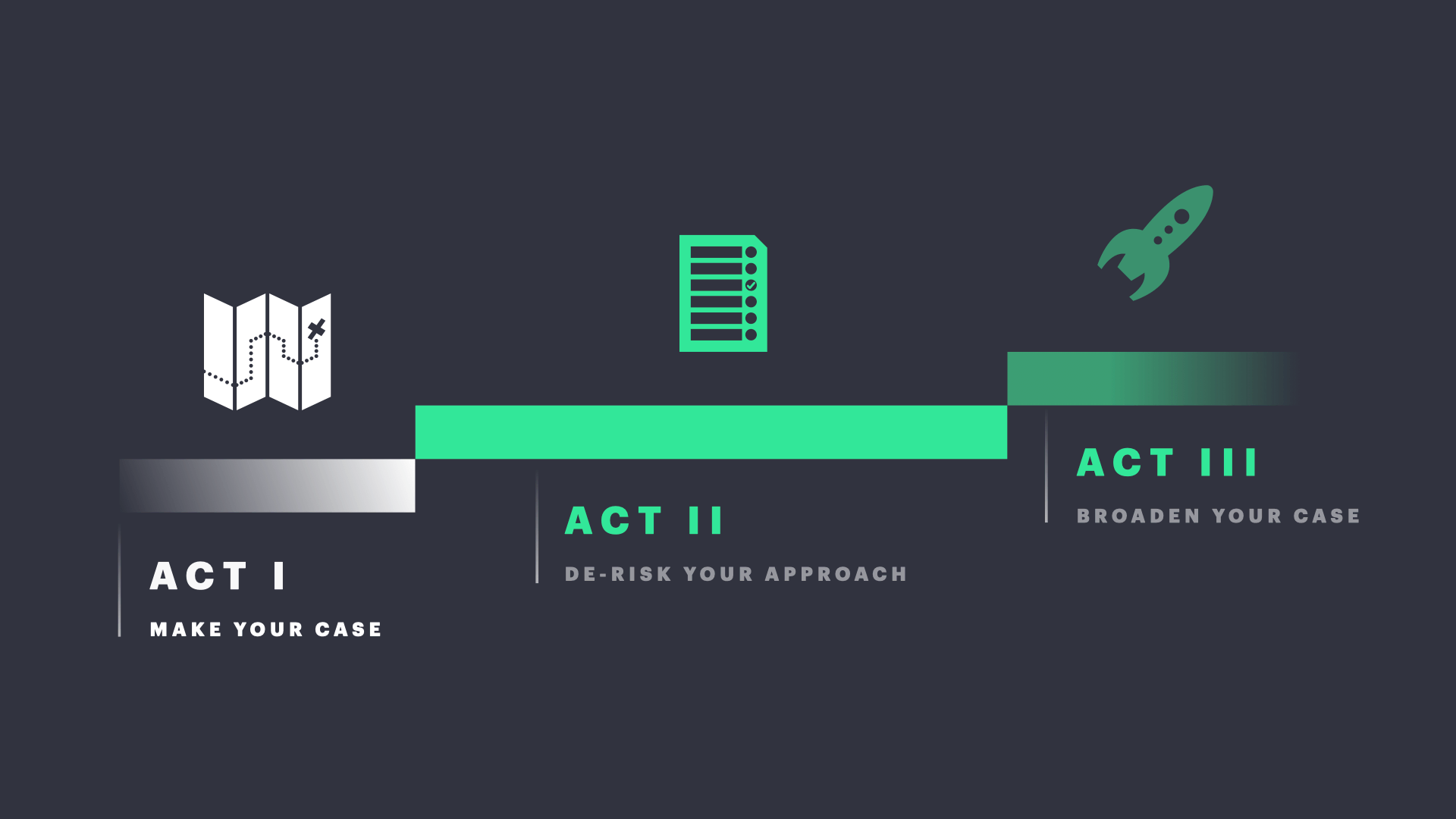没有人会因为喜欢集资而创办公司。但对于许多公司来说,加速风险规模业务的发展需要价值数百万甚至数十亿美元的资本。
遗憾的是,制作集资演示文稿和向投资者推介并不是创始人在创办公司之前就能掌握的技能,而是要在实践中学习。因此,初次创业者往往难以讲好他们的故事,并最终获得投资条款清单。
诚然,每家公司都是独一无二的,但每次推介的目标也是相同的:让风险投资者确信,您的公司有潜力实现超过 10 亿美元的估值。您的初创公司可能还没有盈利,但必须让人产生信心。
这绝非易事,这需要理性和信念的飞跃,也就是说,有效的推介必须灌输信心和激发信念。投资者需要看到您是所在领域的专家,是自己数据的掌握者,并且是那种能够用故事打动客户、员工以及下一轮投资者的讲述者,让他们愿意跟您一起踏上这段非凡旅程。早期创始人,这是为您准备的。这里汇集了六年来制作融资演示文稿的经验,这些演示帮助企业累计融资达 45 亿美元。当您开始筹备种子轮或 A 轮融资时,您需要根据公司所处的阶段,讲述一个兼具愿景和执行力的故事。本资源将帮助您阐明公司存在的理由,并为投资者提供最佳机会,让他们能够预见到您的公司未来可能价值十亿美元。我们开始吧。

要按幕来思考,而不仅仅是关注幻灯片
初创公司界有很多关于推介的传说和丰富的存档资料。有对如今已声名鹊起的公司的早期演示文稿的评论,有风险投资家关于推介的模式匹配帖子,还有大量的演示文稿模板。
我们建议与其只关注幻灯片,不如将您的推介分为三个基本“幕”,并逐一完成。这三个“幕”代表了每个推介的必要环节,让创始人清楚地知道在每个阶段需要证明什么,以及如何证明。
推介的三个幕如下:
- 第一幕:陈述理由。您在做什么?它可能发展成什么?为什么现在是机会?为什么是您来做这件事?
- 第二幕:让人觉得您的方案风险可控。_为了增加成功的可能性,您已经做了哪些准备?
- 第三幕:扩展论点。成功对您、您的投资者和世界意味着什么?

在本指南中,我们将重点讨论第一幕。这是创始人定下推介基调,并为接下来的一切定下框架的部分,而第二幕和第三幕则侧重于公司的具体论据。第一幕是我们在创始人身上花时间最多的地方,我们发现,我们有一半以上的时间都花在制作和完善推介的前几张幻灯片上。这部分实在太重要了。
第一幕及其推介叙事结构
您的演示文稿的第一幕或者说前几张幻灯片必须吸引住投资者。有一种误解认为,您必须严格按照幻灯片的顺序来展示一个令人信服的案例。事实上,推介的第一幕可以包含任何幻灯片组合,只要它能够清楚地传达出以下内容:
- 对市场的独特理解
- 对该市场的重要见解
- 独特的产品或服务
- 表明你的方法行之有效
要在开场几页幻灯片中留下好印象、传达足够信息,确实不是件容易的事,更不用说整份演示文稿。第一幕是重头戏,而且必须高效。多年来,我们注意到在制作强有力的第一幕时,会有一些反复出现的叙述。我们把这些称为推介“叙事结构”或组织故事的框架。选择合适的推介叙事结构是关键的第一步。
五种最常见的推介叙事结构
大多数处于初期阶段的初创公司对应于五种推介叙事结构中的一种。每一种都有类似的结构:
- 故事节点是故事的各个部分,它们相互依存,构成叙事结构。一个好的经验法则是,每个节点分配一张幻灯片和一分钟或更短的讲解。
- 演示文稿示例,每个部分中的演示文稿示例阐述了故事节点之间的关联,以及每个推介叙事结构在实际中的呈现方式。
- 现场记录是我们对每个推介叙事结构的核心观察总结,即它们对创始人和公司来说最有效和最无效的情况。
最后一个重要提示:没有一种叙事结构是最优的,它们都有可能与投资者产生共鸣。在推介之前,先尝试不同的推介叙事结构,找到能让您以最真实、最有说服力的方式阐述您的机遇的那种。
🔄 重新开始
许多投资人喜欢进行大胆的押注,而没有比从零开始彻底重塑市场更大胆的投资了。参考一下特斯拉或 Ethos。或者可以参考经济学家 Joseph Schumpeter,因为这种叙事结构体现了“创造性破坏的狂风”概念,这种狂风会让行业彻底颠覆旧模式,并进行自我重构,从而实现演变。
故事节点
“这就是我们今天市场的混乱现状……”
这里的目的是描绘一个停滞不前的市场、行业或工作流程。也许它仍深陷文书工作的泥潭,它可能涉及数小时的手工操作,而自动化操作只需几秒钟即可完成。也许软件自 1980 年以来就没有改进过。或者它根本就没有起飞。您的目标是让受众感受到这种惰性的低效,无论是通过统计数据、图片,还是一个有力的轶事。
“下面讲它是如何变成现在这个样子……”
引导您的受众。帮助他们了解市场会成为这样的原因。市场是否被没有创新动力或能力的现存企业所主导?是否存在某种历史原因,导致市场必须如此,但现在不需要这样了?是否存在尚未解决的重大技术挑战?无论答案是什么,都应该为您即将揭示的关键见解做好铺垫。
“如果我们能从头开始会怎样?”
抹掉过去的一切,展示您的公司作为新进入者的独特优势。向投资者展示,如果创始人没有老企业的包袱、历史限制和技术局限,这个市场将如何重建。让解决方案看起来简单可行、逻辑清晰且势不可挡。
“这就是我们所做的一切……”
将您的解决方案与您之前描述的混乱局面进行对比。向受众介绍您的产品是如何工作的,重点是从零开始所带来的切实差异:是否比现有方案更快、更经济实惠、更令人愉悦、更省事,或者简单的更好?
演示文稿示例

现场记录
何时奏效。如果您要向投资人介绍一个他们不熟悉的市场,这种叙事结构最为有效。它可以让您展示专业知识,并让投资者独立地评估您的企业。如果您能说服投资者相信,您的公司是唯一采用这种方法的公司,那么您就是投资人唯一需要关注的创始人。
谨慎行事。避免用投资者已经知道的故事来“教育”他们。如果您不知道对您的领域感兴趣的观察者肯定知道的事情,那说明您不了解自己的领域。更糟糕的是,这会传递出负面信号。例如,在向金融科技投资者推介时,不要强调无银行账户挑战。几乎可以肯定他们听过(而且很可能已经资助过)这样的推介。最不想发生的情况是,开场第一张幻灯片就被卷入长达十分钟的争论,或者投资人只是会心点头或面露茫然。同样重要的是,要考虑您的方法的独特之处。例如,如果让您与众不同的是您的营销策略,而不是更有说服力的东西,那么很难说您在从根本上重新定义市场,您的推介可能会显得言过其实。
⬇️ 在这里运用类比
一个准确而有力的类比能起到很大作用,尤其是当您的类比对象估值在 10 亿美元以上时。早期版本的 Catch(“自由职业者版 Gusto”)或 BallerTV(“业余体育版 ESPN”)就非常适合这种叙事结构。当投资者对您的市场还不十分熟悉时,这种做法尤其有用。
故事节点
“看看已经演变的这个其他市场(或这类其他市场)……”
大趋势会影响所有市场,如果您看到其他主要市场被某种趋势所改变,那么很可能这种趋势很快也会影响到您的市场。过去,这些力量可能是移动性、云或物联网。如今,更有可能是人工智能、实时决策或任何正在重塑市场的趋势。这些例子很有说服力,因为它们可以为您接下来介绍的方法做铺垫。
“我们的市场被落下了……”
接下来,要通过说明您的市场当前的运作状况,使这些市场与您的市场形成鲜明对比。重点突出这些力量尚未在您的市场显现所带来的痛点。如果处理得当,就会让人一种必然性的感觉。空缺总会被填补。
“它会变成这样……”
这是你证明类比的机会。描绘一下,如果您的市场符合现代标准会是什么样子。带领观众逐步了解转变体验,以及转变对用户、行业和能够提供这种体验的公司的影响。
“这正是我们在构建的内容……”
将您的公司描述为当今市场与您刚刚描述的完美世界之间的变革推动者。说明您已经为实现这个愿景做了哪些工作,以及还有哪些工作要做。这样做的目的是简单明了地表明,您正在实现这一愿景的道路上前进。
演示文稿示例

现场记录
何时奏效。此叙事结构完全取决于您所处的市场现状与在适当技术的加持下它应该、将会、能够达到的理想状态之间的差距有多大。如果您能把您公司的独特之处浓缩为单一技术或业务模式(如人工智能、SaaS 等),这种方式会特别有效,因为这样一来,您所做的事情与其他市场之间的联系会非常清晰。
谨慎行事。对类比的各个方面进行压力测试,确保逻辑严密、无懈可击。如果您的市场和您用来作类比的市场之间存在任何不一致之处,投资者就会开始质疑您的逻辑。两个市场之间的差异越少越好。您最不想遇到的情况,就是被卷入一场关于另一个您根本不熟悉的市场的争论。另外,投资者很有可能已经在您拿来类比的那个市场上投入过时间和资金,非常了解那个市场。
💡 不过话说回来……
这其实与其说是一种叙事结构,不如说是一种修辞手法。但它却是一种非常有效的开场白。如果您的目标是让投资者相信您是解决这个问题的最佳人选,那您能做的最有力的事情,就是向他们展示,您对这个问题的理解比任何人都深刻。例如,这种叙事结构可能很适合电子邮件服务 Superhuman 的 Rahul Vohra。作为创始人 (Rapportive, Superhuman)、投资者 (sendwithus) 和顾问 (InboxVudu),他花了十多年时间重新构想电子邮件。
故事节点
“我们市场的内部人士知道……”
以一个有趣的事实或统计数据作为开场白,而这个事实或统计数据是投资者所不知道的,也很可能是她在会面前粗略调查所找不到的。理想的情况是,这个统计数据要出乎意料、有悖常理,或者单纯有趣。但最重要的是,这个信息应该为您故事的下一个节点做好铺垫。
“但关键是……”
在此引入您的独特见解。如果是业内人士都知道的观察结果,那么您的见解应该提供一个只有您才能给出的视角。这样做的目的是在开场的事实或统计数据的基础上更深一层地揭示市场的隐藏真相。例如,如果您的有趣事实是您所处的市场正以令人难以置信的速度快速增长,那么您的见解可能是这个市场仍然远小于它本应达到的规模。
“这为我们打开了一扇通向巨大商机的大门……”
下一步是将你的独特见解与眼前的业务机会关联起来。这意味着,凭借你的独特洞察力,您可以打造一家不同于市场上任何其他公司的特定类型的公司。例如,如果您所处的市场渗透率极低,那么您可以专注于您正在打造的产品,您可以强调您正在构建的产品不会立即与现有公司产生竞争,因为它服务的是一个与现有市场相邻的隐藏市场。
“我们为此而生……”
在此背景下介绍您的企业。清楚地阐述贵公司的一切,从产品到进入市场,是如何为利用这一独特洞察而设计的。
演示文稿示例

现场记录
何时奏效。这是一个极具挑战性的叙事结构,因为它要求您同时做到两件事:(1) 提供投资者尚未知晓的事实或统计数据和,(2) 同时提出让人耳目一新的独到见解。因此,当您在信息面比投资人更有优势时,这种策略才最有效。这意味着在行业内工作过并建立了信誉的创始人往往最容易成功。
谨慎行事。如果您的“有趣的事实”或“独特的见解”已经为受众所熟悉,或者对大多数人来说都很直观,那么这个开场白就会显得平淡无奇,您的严谨性或可信度也会受到质疑。因此,当您确定好计划要分享的统计数据或见解时,一定要先验证它们是否真的独特。您可以先让同事、行业内人士或友好投资者了解一下,如果连他们都不觉得有新意,那正式的投资者也不会被打动。
📱 所有人都在这么做
在任何推介中,最大的挑战之一就是展示差异化。要做到这一点,就要展示您的产品如何引发全新的客户行为或以独特的方式从中受益。对于处于早期阶段的 GitHub 或 Figma 来说,这种叙事结构可能是首选。
故事节点
“用户行为正在发生重大转变……”
这种叙事结构以为您的公司奠定基础的潜在趋势为开头,但这个趋势不是您在其他任何推介中都能听到的趋势。您需要给人一种感觉,您发现了一种趋势,而不仅仅是从别的地方读到的趋势。因此,要避开 Gartner 的研究和消费者调查,寻找能揭示隐藏在人们视线中的趋势的数据或轶事。试想一下,初期的 Airbnb 指出,在 Craigslist 等网站上出现的临时住房列表证明人们对非酒店住宿感兴趣。
“现有公司还没有为这种趋势做好准备……”
如果您已经有效地证明某种趋势确实存在,那么您的下一个任务就是要证明,现有公司要么没有看到这种趋势,要么无法快速应对这种趋势。阐明用户的期望与现有公司提供的服务之间的落差。
“我们早就预见到了这一切……”
利用您的起源故事来阐述创始人与市场的契合度。表明您正处于机遇的风口浪尖,而您已经为此准备了多年,这并不是偶然,而是因为您一直在进行规划。展示您的公司是如何在深刻理解这一趋势的基础上建立起来的,以及这一切如何转化为您的产品开发、上市、团队组建等方案。
“我们创办的公司为这个新世界而生……”
提供早期证据,证明您正从这一趋势中受益。这可以是早期的进展、客户评价或任何其他表明您正在与早期采用者产生共鸣的迹象。让投资者感觉您已经发现了必然趋势。
演示文稿示例

现场记录
何时奏效。如果您的公司走在新兴趋势的前沿,而其他人还没有注意到,这种叙事结构就很有力。Airbnb 是个很有启发性的例子。理想情况下,只有深入研究数据,才能发现您所识别的趋势。趋势应该是只有您在寻找并发现的东西。划时代的洞察很可能无法通过 Google 搜索获得;展示出您挖掘到这种信息。
谨慎行事。投资者正在寻找改变市场的长期趋势,而不是一时的热潮。最近几个月,我们看到一个又一个的推介将新冠疫情作为其市场或产品的转折点来讲。但是,您所看到的变化是否会在疫情之后持续下去?如果是,您如何向投资者说明这一点?
✋ 我把它当作自己的事情
投资者正在寻找那些为解决问题而全身心投入的创始人,这意味着如果您能讲述这个问题如何对您个人产生影响,就会非常有力。例如,John Crowley 当时就能采用这种叙事结构。当他的两个孩子被诊断出患有庞贝氏病时,Crowley 放弃了金融行业的职业生涯,转而为患有罕见疾病且选择很少的人开发治疗方法。为了帮助自己的孩子,他花了几十年的时间在生物技术和制药公司工作并创办了这种类型的公司。现在,他是 Amicus Therapeutics 领导者,该公司为罕见代谢疾病患者发现、开发和提供药物。
故事节点
“我讲一个我曾经尝试/不得不做某件事的故事……”
分享您的个人奋斗故事。这可以是一个“如鱼离水”的故事,您作为局外人第一次尝试某些事情(例如申请抵押贷款)。也可以是一个“内部挑战”故事,讲述您如何与长期困扰您实践社区成员的问题作斗争(例如,人工审核抵押贷款申请表)。
“那真一次糟糕的经历……”
用两到三个核心障碍总结您刚才讲的故事,这些障碍阻止流程达到顺畅、直观、简单或高效的状态。在这里,您要提出在创办公司之前必须相信自己能够解决的问题。
“我做了调查……”
回顾一下您为更好地了解这个问题所采取的步骤。您与谁交谈过?对于这个问题的规模和范围,您了解到了什么?您花了多长时间反复迭代您的想法?您招募了哪些人来帮助您解决这项挑战?这些故事都能引起投资者的共鸣,让他们相信您致力于解决面临的问题。
“我打造了自己想要的解决方案……”
阐述您的产品如何解决您所面临的问题。但要迅速过渡到您的产品能为整个市场带来的价值。这是您证明自己在解决问题的过程中发现了巨大商机的机会。
演示文稿示例

现场记录
何时奏效。我们只建议那些有真实故事可讲的创始人使用这种叙事结构。创始人强行把自己塑造成故事中的英雄,会让投资者感到厌烦。但是,如果您的起源故事本身就是您向客户或员工分享的叙事核心,那说明这种故事也很可能引起投资者的共鸣。
谨慎行事。即使您的故事是真实的,也只有在让人产生共鸣时才有效。投资者不一定要亲身经历过这个问题,但他们应该能够设身处地理解您的处境。如果问题过于复杂、晦涩,或者感觉只是“可有可无”而非“必须解决”,那么个人故事不仅可能失去吸引力,还可能失去价值。
叙事结构变得复杂
一旦您选择了推介叙事结构,您就迈出了确定集资演讲的重要一步。坚持您的演示文稿结构,构建推介的第二幕和第三幕。如果您需要帮助,请观看我们的 AMA 录制视频,我们在其中深入探讨了集资演讲。了解有关 4th & King 的更多信息,请发送邮件联系我们:hello@4thandking.com
Stripe Atlas 还有其他资源可帮助您集资。如需了解更多信息,请访问推介处于早期阶段的初创公司。如需了解类似的初创公司指南,或者对于哪些其他指南对您的在线业务会有帮助,您有任何想法,请发送邮件联系我们:atlas@stripe.com

